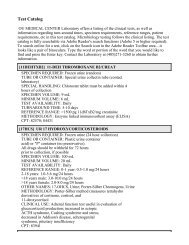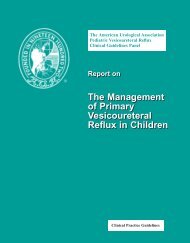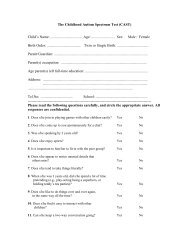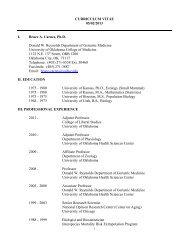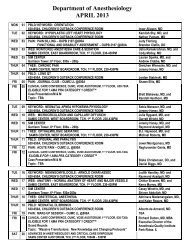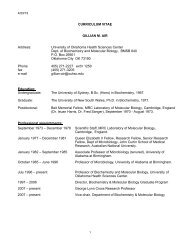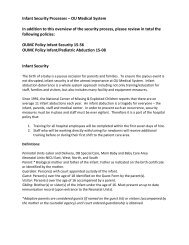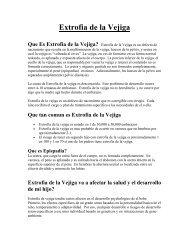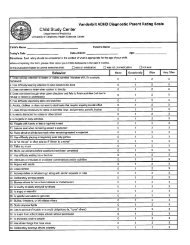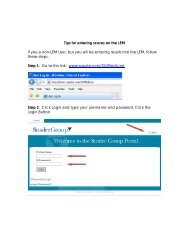October 2010 OU Medicine Leadership Academy - Hardwiring ...
October 2010 OU Medicine Leadership Academy - Hardwiring ...
October 2010 OU Medicine Leadership Academy - Hardwiring ...
Create successful ePaper yourself
Turn your PDF publications into a flip-book with our unique Google optimized e-Paper software.
<strong>Leadership</strong> <strong>Academy</strong><br />
Denise Dwight<br />
EXCEL Coach<br />
<strong>October</strong> 28, <strong>2010</strong>
Relate not Compare!!<br />
2
Learning Objectives:<br />
Review Linkage Grid Execution Results to Date<br />
Connect to Purpose & How to Make it Stick “Hardwire”<br />
‣ Rounding on Staff<br />
‣ Thank You Notes<br />
‣ AIDET<br />
New Communication Tool<br />
‣ Stop Light Report<br />
3
So…..Who Are You?<br />
4
ATTITUDE<br />
IS<br />
EVERYTHING<br />
You Become what<br />
you think<br />
5
Group Exercise<br />
<strong>Leadership</strong>:<br />
‣Think of the best leader you have every worked for.<br />
What was it about that leader that made them a great<br />
leader?<br />
‣Write down your thoughts and prepare to share in<br />
large group.<br />
6
Group Exercise<br />
<strong>Leadership</strong>:<br />
‣As a leader, what legacy do you want to leave behind<br />
at <strong>OU</strong>?<br />
7
PASSION<br />
Wherever you choose to go, go there with all your<br />
heart.<br />
Passion fuels Enthusiasm<br />
(Passion, Ownership and Urgency)<br />
8
Passion and Prescriptives<br />
Passion<br />
Prescriptives<br />
9
Healthcare Flywheel ®<br />
Prescriptive<br />
To Do’s<br />
Rounding<br />
for<br />
Outcomes<br />
AIDET<br />
Purpose,<br />
worthwhile work<br />
and making<br />
a difference<br />
• Bottom Line<br />
Results<br />
(Transparency and<br />
Accountability)<br />
• Reduced TO<br />
• Increased Quality<br />
• Reward &<br />
Recognition<br />
• Increased<br />
Satisfaction<br />
Self-<br />
Motivation<br />
®<br />
10
Evidence Based <strong>Leadership</strong> (EBL)<br />
Foundation<br />
STUDER GR<strong>OU</strong>P:<br />
Leader<br />
Evaluation<br />
Leader<br />
Development<br />
Must<br />
Haves SM<br />
Performance<br />
Gap<br />
Standardization<br />
Accelerators<br />
Implement an<br />
organizationwide<br />
leadership<br />
evaluation<br />
system to<br />
hardwire<br />
objective<br />
accountability<br />
(Principle 7)<br />
Aligned Goals Aligned Behavior Aligned Process<br />
Create process<br />
to assist<br />
leaders in<br />
developing<br />
skills and<br />
leadership<br />
competencies<br />
necessary to<br />
attain desired<br />
results<br />
(Principle 4 & 8)<br />
Must Haves SM<br />
Rounding<br />
Thank You Notes<br />
Employee<br />
Selection<br />
Pre and Post<br />
Phone Calls<br />
Key Words at<br />
Key Times<br />
(Principle 3, 5, 6, & 9)<br />
Re-recruit<br />
high and<br />
middle<br />
performers<br />
Move low<br />
performers up<br />
or out<br />
(Principle 4)<br />
Agendas<br />
by pillar<br />
Peer<br />
interviewing<br />
30/90 day<br />
sessions<br />
Pillar goals<br />
(Principle 1 & 2)<br />
Leader Eval Mgr<br />
(LEM)<br />
Staff Eval Mgr<br />
(SEM)<br />
Discharge Call<br />
Manager (DCM)<br />
Rounding Mgr<br />
Idea Express<br />
11
Linkage Grid Results<br />
No<br />
Yes<br />
DESK Conversations<br />
No<br />
Yes<br />
Rounding on your employees or internal customers<br />
No<br />
Yes<br />
Managing Up<br />
Response percent<br />
Response total<br />
No<br />
Yes<br />
Thank you notes<br />
All responses - 31<br />
Incomplete surveys<br />
No<br />
Yes<br />
Communication<br />
0 10 20 30 40 50 60 70 80<br />
12
Connect to Purpose Communication<br />
13
Thank You Notes<br />
14
Managing Up<br />
15
Round on Employees & Internal Customers<br />
16
DESK Conversation<br />
17
Barriers<br />
• Time<br />
• Extremely Busy<br />
• Not Enough Hours in the Day<br />
• Heavy Workload<br />
• Short Staffed and Training New Employees<br />
• Have done but not consistent<br />
• Need note cards to write thank you notes<br />
18
Rounding for<br />
Outcomes<br />
19
Rounding for Outcomes<br />
• Senior Leader Rounding<br />
• Rounding on Staff<br />
• Rounding on Patients<br />
• Rounding on Internal Customers<br />
20
Employee Engagement: The 12 Items That Matter<br />
Q12. This last year, I have had opportunities at work to learn and grow.<br />
Q11. In the last six months, someone at work has talked to me about my progress.<br />
Q10. I have a best friend at work.<br />
Q09. My associates or fellow employees are committed to doing quality work.<br />
Q08. The mission or purpose of my company makes me feel my job is important.<br />
Q07. At work, my opinions seem to count.<br />
Q06. There is someone at work who encourages my development.<br />
Q05. My supervisor, or someone at work seems to care about me as a person.<br />
Q04. In the last seven days, I have received recognition or praise for doing good<br />
work.<br />
Q03. At work, I have the opportunity to do what I do best every day.<br />
Q02. I have the materials and equipment I need to do my work right.<br />
Q01. I know what is expected of me at work.<br />
21
Employee Satisfaction Increase<br />
<strong>2010</strong><br />
<strong>2010</strong><br />
Overall Overall RSFH 96.8%tile<br />
RSFHCorporate Services 96.8%tile 98.4%tile<br />
Corporate Bon Secours St.<br />
Services Francis 98.4%tile 96.8%tile<br />
Roper<br />
96.8%tile<br />
Bon Secours<br />
St. Francis 96.8%tile<br />
Roper<br />
96.8%tile<br />
Source: South Carolina Hospital, Admissions=25,837 Total beds = 594, vendor = PRC<br />
22
Rounding for Outcomes: Leaders Rounding on<br />
Staff and Physicians<br />
Impact of Rounding on Willingness to Recommend as a<br />
Impact of Rounding on Willingness to Recommend KPNW as a<br />
Place to to Work Work<br />
% favorable Recommend for Work<br />
100%<br />
80%<br />
60%<br />
40%<br />
20%<br />
0%<br />
50.2%<br />
Never<br />
55.6%<br />
Rarely<br />
(Couple times a year)<br />
79.3%<br />
Often<br />
(At least quarterly)<br />
87.4%<br />
Tactic and Tool Implemented:<br />
• Leader Rounding on Staff and Physicians<br />
Frequently<br />
(At least Monthly)<br />
Frequency of Rounding<br />
Oregon Integrated Health System; 8700<br />
employees<br />
* Results are one year following implementation of Leader Rounding on Staff<br />
and Physicians; Staff and physicians rounded on at least monthly had the<br />
highest satisfaction levels.<br />
23
PEOPLE<br />
65%<br />
<strong>OU</strong> Physicians Employee Turnover<br />
55%<br />
45%<br />
35%<br />
25%<br />
15%<br />
5%<br />
Jul-08 Aug-08 Sep-08 Oct-08 Nov-08 Dec-08 Jan-09 Feb-09 Mar-09 Apr-09 May-09 Jun-09 Jul-09 Aug-09 Sep-09 Oct-09 Nov-09 Dec-09<br />
Total 33% 27% 23% 22% 22% 22% 22% 21% 21% 21% 21% 21% 14% 14% 14% 14% 13% 14%<br />
Voluntary 27% 21% 19% 18% 18% 18% 18% 17% 16% 16% 16% 16% 12% 12% 12% 11% 10% 11%<br />
GOAL = Maintain a Voluntary Turnover Rate<br />
of 15% or less<br />
24
What All Types of Rounding Have in Common<br />
• Proactively engaging, listening to, communicating<br />
with and supporting our most important customers<br />
(family, employees, patients, partners, and other<br />
departments)<br />
• The exact opposite of an open door policy<br />
25
Rounding –<br />
Not a New Concept but will look different<br />
26
Rounding on Direct Reports:<br />
Outcomes<br />
Outcomes:<br />
• Build relationships<br />
• Harvest wins<br />
• Identify process improvement<br />
needs<br />
• Repair and monitor systems<br />
• Coach and reinforce<br />
behaviors<br />
What direct reports want in a<br />
Leader:<br />
• A good relationship<br />
• Approachability<br />
• Efficient systems<br />
• Training and development<br />
• Tools and equipment<br />
• Appreciation<br />
27
Rounding Log<br />
• Rounding logs<br />
are not optional<br />
• After rounding<br />
for outcomes<br />
begin to round<br />
with coaching<br />
28
Stoplight Report<br />
(connect the dots from rounding)<br />
• We can’t do now and here<br />
is why<br />
• Work in progress<br />
• Completed!<br />
29
Table Exercise<br />
‣Pair up in two’s<br />
‣Round on each other asking prescribed questions and<br />
documenting your findings<br />
‣Each will be in the role of leader and staff<br />
‣5 minutes each round<br />
‣Share experiences as a group<br />
• Something you learned that you didn’t know before?<br />
30
Next Steps<br />
• Share Leader Rounding on Staff with Stoplight Report at next<br />
staff meeting<br />
• Round on Staff at <strong>OU</strong> Standard<br />
– Document on rounding log<br />
– Action items on stoplight report<br />
– Share learning’s each month at Staff Meeting<br />
• Monthly Meetings with Supervisor<br />
– Use Monthly Meeting Model<br />
‣ Share logs & stoplight report<br />
‣ Staff Agenda<br />
‣ Manage Up – Thank you Note for Staff and Physician<br />
31
Denise Dwight, EXCEL Coach<br />
A<br />
Acknowledge<br />
I<br />
Introduce<br />
D<br />
E<br />
T<br />
Duration<br />
Explanation<br />
Thank You<br />
32
Key Words at Key Times<br />
33
Five Fundamentals of Consistent<br />
Communication – Key Words<br />
Safety<br />
A<br />
Acknowledge<br />
Decrease<br />
Anxiety<br />
Increase<br />
Compliance<br />
Quality<br />
I<br />
D<br />
E<br />
Introduce<br />
Duration<br />
Explanation<br />
Patient<br />
Loyalty<br />
T<br />
Thank You<br />
34
HCAHPS Questions<br />
Composite Question Summary Response Scale<br />
Nurse courtesy and respect<br />
ALWAYS, Usually, Sometimes, Never<br />
Nurses listen carefully<br />
ALWAYS, Usually, Sometimes, Never<br />
Nurse explanations are clear<br />
ALWAYS, Usually, Sometimes, Never<br />
Doctor courtesy and respect<br />
ALWAYS, Usually, Sometimes, Never<br />
Doctors listen carefully<br />
ALWAYS, Usually, Sometimes, Never<br />
Doctor explanations are clear<br />
ALWAYS, Usually, Sometimes, Never<br />
Did you need help in getting to bathroom? 2 Yes No (screening question)<br />
Staff helped with bathroom needs<br />
ALWAYS, Usually, Sometimes, Never<br />
Call button answered<br />
ALWAYS, Usually, Sometimes, Never<br />
Did you need medicine for pain? 2<br />
Yes, No (screening question)<br />
Pain well controlled<br />
ALWAYS, Usually, Sometimes, Never<br />
Staff helped patient with pain<br />
ALWAYS, Usually, Sometimes, Never<br />
Were you given any new meds? 2<br />
Yes, No (screening question)<br />
Staff explained medicine<br />
ALWAYS, Usually, Sometimes, Never<br />
Nursing<br />
Communication<br />
Doctor<br />
Communication<br />
Responsiveness<br />
of Staff<br />
Pain<br />
Management<br />
Communication<br />
of<br />
Medications<br />
Staff clearly described side effects<br />
ALWAYS, Usually, Sometimes, Never<br />
Did you go home, someone else’s home, or Own home, Someone else’s home, Another<br />
to another facility? 2<br />
facility (screening question)<br />
Staff discussed help need after discharge YES, No<br />
Written symptom/health info provided YES, No<br />
NA Area around room kept quiet at night ALWAYS, Usually, Sometimes, Never<br />
NA Room and bathroom kept clean ALWAYS, Usually, Sometimes, Never<br />
DEFINITELY YES, Probably Yes, Probably No,<br />
NA<br />
Willingness to Recommend<br />
Definitely No<br />
NA Hospital Rating Question 0 to 10 point scale (percent 9 and 10 reported)<br />
Discharge<br />
Information<br />
35
Value Based Purchasing<br />
• VBP will transition providers from HCAHPS pay-for-reporting to<br />
pay-for-performance, and the amount of reimbursement tied to<br />
the survey will potentially double by 2017<br />
• It’s about how well our organization can demonstrate that it has<br />
hardwired quality<br />
• Pay for Quality is here<br />
36
CMS Value Based Purchasing<br />
Core Measures<br />
(70% Weight)<br />
P 4 P<br />
(Pay for<br />
Performance)<br />
+<br />
Performance will<br />
determine total hospital<br />
reimbursement<br />
HCAHPS<br />
(30 % Weight)<br />
Plan Due by January 2012<br />
Implementation FY 2013 (Oct 2012)<br />
37
AIDET ~ Outcomes<br />
100<br />
90<br />
80<br />
70<br />
60<br />
50<br />
40<br />
30<br />
20<br />
10<br />
0<br />
Increase of<br />
28%ile points<br />
Increase of<br />
17%ile points<br />
Outpatient Inpatient ED<br />
Increase of<br />
16%ile points<br />
Baseline<br />
6 Months Post<br />
Source: 2007 AIDET product evaluation survey of<br />
PARTNERS and NONPARTNERS, N=68<br />
38
AIDET – Finance - Decrease Litigation<br />
70<br />
60<br />
50<br />
40<br />
30<br />
20<br />
10<br />
50% decrease<br />
in complaints<br />
# of Complaints<br />
# of Compliments<br />
0<br />
*Data provided by University Medical Center, Tucson, AZ<br />
1Q07 2Q07 3Q07<br />
**Source: 2007 AIDET product evaluation survey of PARTNERS and NONPARTNERS<br />
39
AIDET SM – Impact on Safety and Quality<br />
Change in Percentile Ranks<br />
Ease of obtaining test results (60.0%)<br />
CP instructions for follow-up care (80.0%)<br />
CP information about medications (73.5%)<br />
CP efforts to include in decisions (73.3%)<br />
CP concern for prob/condition (84.2%)<br />
Access to care (46.5%)<br />
Overall Patient Satisfaction (53.0%)<br />
Post AIDET<br />
Pre AIDET<br />
0 10 20 30 40 50 60 70 80 90 100<br />
Percentile Rank<br />
Source: Oklahoma University; <strong>OU</strong>P Hematology/Oncology Clinic & Infusion Center; 10 providers & 22 staff, take care of 15,000<br />
clinic visits & 10,000 chemotherapy infusions per year<br />
40
AIDET - Finance and Growth<br />
• For every customer that complains, 20 dissatisfied customers<br />
do not<br />
• Of those dissatisfied customers who do not complain, 90% do<br />
not return<br />
• The average wronged customer will tell 25 others<br />
• It is 10 times more expensive to recruit new patients than to<br />
keep old ones<br />
-Zimowski 2004<br />
41
AIDET - Patient Loyalty<br />
“In fact the only path to profitable growth may<br />
lie in a company’s ability to get its loyal<br />
customers to become its marketing<br />
department.”<br />
-THE ONE NUMBER Y<strong>OU</strong> NEED TO GROW<br />
Frederick F. Reichheld - Harvard Business Review Dec 2003<br />
42
Five Fundamentals of Consistent Communication<br />
– Key Words<br />
Safety<br />
A<br />
Acknowledge<br />
Decrease<br />
Anxiety<br />
Increase<br />
Compliance<br />
Quality<br />
I<br />
D<br />
E<br />
Introduce<br />
Duration<br />
Explanation<br />
Patient<br />
Loyalty<br />
T<br />
Thank You<br />
43
Group Exercise<br />
‣Develop AIDET as you would like to hear your staff execute at<br />
the highest level<br />
‣Pair up in two’s<br />
‣ Role Play AIDET prior to today’s LA<br />
‣ Role Play New AIDET developed at LA<br />
‣Share experience as a group<br />
44
How Do We Make AIDET ‘Stick?’<br />
45
Rounding – Validate AIDET<br />
• Rounding for Outcomes<br />
– Rounding on Direct Reports<br />
– Rounding on Patients<br />
• Direct Observation<br />
• Patient Satisfaction Results<br />
• Patient Perception of Care Results<br />
46
Add Questions to<br />
Rounding on Staff Log<br />
‣Share with me how<br />
you are using AIDET<br />
with every encounter?<br />
‣Share with me a<br />
tough “D” you had to<br />
deliver?<br />
‣Share example of<br />
how you took “I” to the<br />
next level<br />
47
AIDET – Observed Validation<br />
Identifies the purpose of using the AIDET principle.<br />
Performance Criteria<br />
Utilizes the AIDET principle to communicate with others, with a focus on patients and their families:<br />
Self Assessment<br />
Place an X in<br />
box 1, 2, or 3<br />
(See legend)<br />
1 2 3 S D<br />
O<br />
Evaluator's<br />
Assessment (see<br />
legend)<br />
1 2 3<br />
S D S<br />
O<br />
ACKNOWLEDGES the customer:<br />
• A smile, makes eye contact, greets them and calls them by name in a pleasant manner.<br />
INTRODUCES self:<br />
• States name and role at HOSPITAL NAME.<br />
• Highlights skill and expertise of self and other healthcare team member.<br />
DURATION:<br />
• Gives the customer a time expectation.<br />
• Keeps the customer informed as to the amount of time a procedure or/process will take.<br />
• Includes letting them know if there is a wait time; gives time expectation of that wait.<br />
EXPLANATION:<br />
• Keeps customer informed by explaining all processes and procedures<br />
• Communicates clear expectations of what will be occurring.<br />
THANKS the customer:<br />
• Thanks customer for their time and,<br />
• Expresses appreciation to the customer for their cooperation and communication<br />
• Asks if there is anything else he/she can do for the customer before ending the interaction.<br />
Ensures non-verbal communication conveys the AIDET principle:<br />
• Makes eye contact.<br />
• Respects the patient’s personal space (as possible).<br />
• Listens to what the patient is saying; allows for silence; does not interrupt with his/her own<br />
thoughts.<br />
• Ensures body language is relaxed, open and non-threatening.<br />
• Displays a calm manner.<br />
________________________________________<br />
Competency Met ________________________________________<br />
Employee signature Date Evaluator's Signature Date<br />
________________________________________<br />
Employee signature Date Improvement Plan Completed ______________________________<br />
____________________________________________ Evaluator's Signature Date<br />
Employee signature<br />
Date<br />
D<br />
O<br />
48
Next Steps<br />
• Meet with Staff<br />
– Develop AIDET Guide<br />
• Update Rounding on Staff Log<br />
‣ Add AIDET Questions to Rounding Log<br />
Share with me how you are using AIDET with every encounter?<br />
Share with me a tough “D” you had to deliver?<br />
Share example of how you took “I” to the next level<br />
• Update Leader Rounding on Patient Log - if applicable<br />
• Observe staff execute AIDET<br />
– Document on AIDET Competency Form<br />
49
Monthly Meetings with your Supervisor<br />
• Monthly Meeting Model<br />
– Share Linkage Grid Action Steps to Date<br />
– Rounding on Staff ~ Manage Up ~ Thank You Notes<br />
‣ Share Monthly Agenda with Rounding on Staff<br />
‣ Share completed rounding logs & Stoplight Report<br />
‣ Share Recognition and Manage Up to Supervisor<br />
1 employee<br />
1 physician<br />
– AIDET<br />
‣ Share AIDET Competency Assessment Forms<br />
Progress to Date<br />
% Complete<br />
50
•<strong>Leadership</strong> & Attitude<br />
‣As a leader, what legacy do you want to leave behind at <strong>OU</strong>?<br />
‣ Closing thought for the day……<br />
“To accomplish great things we must not only act, but also dream;<br />
not only plan but also believe.”<br />
Anatole France<br />
51
Never Underestimate<br />
the Difference You Can<br />
Make<br />
~ Quint Studer ~<br />
52
Thank you!!!<br />
Denise Dwight – denise.dwight@studergroup.com<br />
Visit: www.studergroup.com<br />
53



